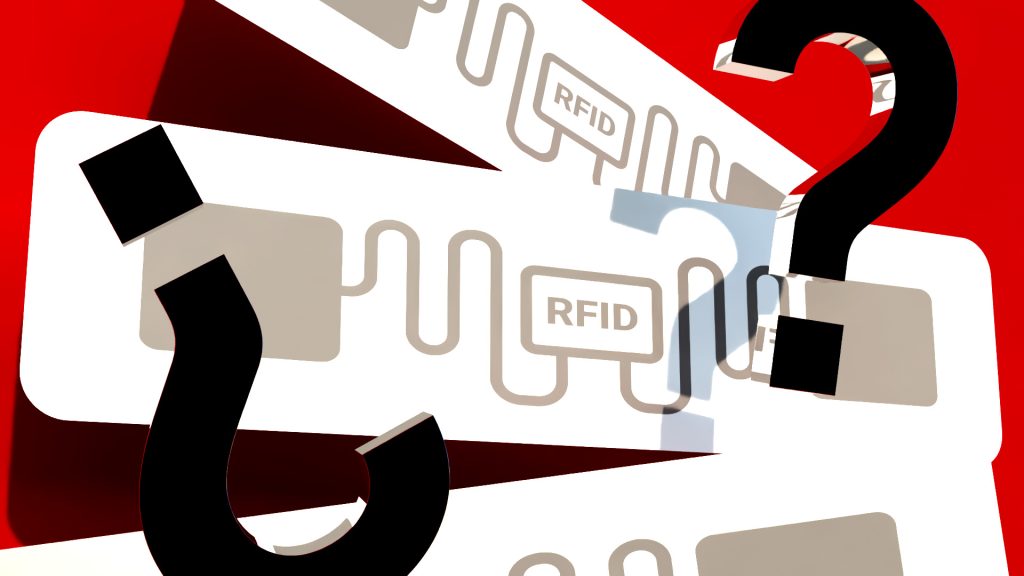What are RFID Tags and How Do They Work?
RFID, or Radio Frequency Identification, is a technology that uses radio waves to identify and track objects. Essentially, an RFID tag is a small electronic device that contains a microchip and an antenna. This tag holds information that can be read by an RFID reader. When an RFID reader emits radio waves, it activates the tag, causing it to transmit the stored data back to the reader
There are three main types of RFID tags:
- Passive Tags: These tags have no internal power source. They rely on the energy from the RFID reader’s radio waves to activate and transmit data. Passive tags are typically smaller, less expensive, and have a shorter read range compared to other types.
- Active Tags: Equipped with a power source, such as a battery, active tags can continuously transmit data without requiring a reader’s signal. They offer longer read ranges and can be used in environments with challenging conditions, like metal or liquid.
- Semi-Active Tags: These tags combine features of both passive and active tags. They have a small internal battery that supplements the energy received from the reader, extending the read range and data transmission capabilities compared to passive tags.
Types of RFID Tags
- RFID Labels for Laboratories: These tags are specifically designed to withstand harsh laboratory environments, including exposure to chemicals and extreme temperatures.
They are typically passive tags embedded in labels that can be affixed to various lab equipment, samples, and reagents. This allows for efficient tracking of inventory, sample management, and process automation.
- RFID Tags for Laundry: Used in commercial laundries, these tags are often attached to garments or linens. They enable automated tracking of items throughout the washing, drying, and folding process. This improves efficiency, reduces loss, and ensures accurate item identification.
- RFID Tags for Vehicles: From cars to shipping containers, RFID tags can be used to track vehicle location, monitor fleet performance, and streamline logistics. These tags can be passive, active, or semi-active, depending on the specific application and required read range.
- RFID Labels for Retail: In the retail industry, RFID labels are attached to products to enhance inventory management, loss prevention, and customer experience. These tags can be used for self-checkout systems, product tracking, and supply chain visibility.
- RFID Tags for Metals: Designed to function effectively on metal surfaces, these tags overcome the challenges posed by metal interference. They are commonly used in automotive, manufacturing, and industrial settings for asset tracking and inventory control.
- RFID Tags for Timing: These specialized tags are used in applications requiring precise timing, such as sports events, racing, and industrial process control. They can capture data related to start, finish, and intermediate checkpoints with high accuracy.
- Rugged RFID Tags: Built to withstand harsh environments, rugged RFID tags are ideal for use in industries like logistics, transportation, and construction. They can withstand extreme temperatures, moisture, and physical impact.
- Standard RFID Tags: These are general-purpose RFID tags suitable for a wide range of applications where environmental conditions are not particularly challenging. They offer a balance of cost and performance.
By understanding the diverse range of RFID tag types, businesses can select the optimal solution to meet their specific needs and improve efficiency, accuracy, and productivity.
How are RFID Tags Being Used?
RFID technology has found its way into numerous industries, revolutionizing processes and improving efficiency. Here are some prominent use cases:
- Supply Chain Management: RFID tags are widely used to track products as they move through the supply chain, from manufacturing to the end consumer. This provides real-time visibility into inventory levels, shipment status, and product location.
- Retail: In retail stores, RFID tags can be attached to products for faster checkout, inventory management, and loss prevention. They also enable advanced functionalities like smart shelves and product tracking.
- Healthcare: RFID tags are employed in hospitals and clinics for patient tracking, asset management, and drug management. They help ensure patient safety, improve operational efficiency, and reduce medical errors.
Logistics and Transportation: RFID tags are used to track shipments, containers, and vehicles. This enhances visibility, reduces transit times, and improves overall supply chain efficiency.
- Manufacturing: RFID tags can be used to track production processes, monitor equipment, and manage inventory. This leads to increased productivity, reduced downtime, and improved quality control.
- Animal Tracking: RFID tags are implanted in animals for identification, tracking, and monitoring purposes. This is commonly used in livestock management, pet identification, and wildlife conservation.
- Access Control: RFID tags can be used for secure access to buildings, facilities, and restricted areas. They provide a convenient and secure alternative to traditional access methods.
These are just a few examples of how RFID tags are being utilized across various industries. As technology continues to advance, we can expect even more innovative applications to emerge.
What are RFID Tags Composed of?
An RFID tag is a sophisticated electronic device composed of several key components.
- Material or Substrate: This is the base material upon which the other components are built. The substrate can vary greatly depending on the tag’s intended use. Common materials include plastic, paper, metal, and even ceramic. The choice of material impacts the tag’s durability, flexibility, and overall performance.
- Antenna: This component is crucial for transmitting and receiving radio waves. It’s typically made of a conductive material like copper or aluminum, though other materials can be used. The antenna’s design and size influence the tag’s read range and overall efficiency.
- RFID Chip: Often referred to as an integrated circuit (IC), the RFID chip is the tag’s “brain.” It stores the unique identification number and other data, processes information, and controls the tag’s communication with the RFID reader. The chip’s memory capacity and processing power determine the tag’s capabilities.
These three components work together to create an RFID tag that can be used in a wide range of applications.
Advantages of RFID Tags
RFID technology offers a multitude of benefits across various industries. Here are some key advantages:
- Durability: Many RFID tags are designed to withstand harsh conditions, including extreme temperatures, moisture, and physical impact. This durability ensures the longevity of the tags and the reliability of the data they carry.
- Real-Time Tracking: RFID enables continuous and immediate monitoring of assets, products, or people. This real-time visibility empowers businesses to make informed decisions, optimize operations, and improve response times.
- Enhanced Security: RFID tags can be equipped with encryption and authentication features to protect sensitive data. They also help prevent counterfeiting and unauthorized access, enhancing overall security.
- Reduced Labor Costs: By automating tasks such as inventory management, asset tracking, and supply chain visibility, RFID technology can significantly reduce labor costs and improve operational efficiency.
- Improved Accuracy: RFID systems provide highly accurate data capture and tracking, minimizing errors and discrepancies. This leads to better inventory control, reduced losses, and enhanced overall process reliability.
- Increased Efficiency: RFID technology streamlines processes, reduces manual data entry, and optimizes workflows. This leads to increased productivity, faster turnaround times, and improved customer satisfaction.
These advantages, among others, have contributed to the widespread adoption of RFID technology across diverse sectors.
Disadvantages of RFID Tags
While RFID technology offers significant advantages, it also comes with certain drawbacks.
Security Issues: One of the primary concerns with RFID tags is security. Unlike barcodes, RFID tags are wireless and can be read from a distance, making them susceptible to unauthorized access. Information stored on these tags can be intercepted by malicious individuals, potentially leading to data breaches and identity theft. Additionally, the lack of standardized security protocols across different RFID systems poses further challenges in safeguarding sensitive data.
Set Up Issues: Implementing an RFID system can be time-consuming and costly. Businesses need to invest in compatible hardware, software, and training. Moreover, the process of testing and optimizing the system can be lengthy and resource-intensive.
Technology Issues: RFID technology is not without its technological limitations. Signal interference from metal, water, or other electronic devices can disrupt tag reading. Furthermore, the phenomenon known as “collision” occurs when multiple tags are read simultaneously, leading to data errors. These challenges can impact the overall reliability and efficiency of RFID systems.
How Long Do RFID Tags Last?
The lifespan of an RFID tag depends on several factors, including the tag type, environmental conditions, and usage frequency.
- Passive RFID Tags: These tags have no internal power source and rely on the energy from the RFID reader. As a result, they have a remarkably long lifespan, often estimated to be around 20 years or more under normal conditions.
- Active RFID Tags: Equipped with a battery, active tags have a shorter lifespan, typically ranging from one to three years. The battery life depends on factors like tag usage, temperature, and the battery’s capacity.
- Semi-Active RFID Tags: These tags fall between passive and active tags in terms of lifespan. They have a small internal battery to supplement the energy from the reader, extending their life compared to passive tags but not as long as active tags.
It’s important to note that these are general estimates, and the actual lifespan of an RFID tag can vary significantly depending on specific factors.
Lior Rubin
Socio Estratégico RSI Mexico









